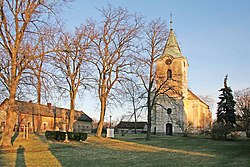Kratonohy
Municipality in Hradec Králové, Czech Republic From Wikipedia, the free encyclopedia
Municipality in Hradec Králové, Czech Republic From Wikipedia, the free encyclopedia
Kratonohy is a municipality and village in Hradec Králové District in the Hradec Králové Region of the Czech Republic. It has about 600 inhabitants.
Kratonohy | |
|---|---|
 Church of Saint James the Great | |
| Coordinates: 50°10′9″N 15°36′25″E | |
| Country | |
| Region | Hradec Králové |
| District | Hradec Králové |
| First mentioned | 1316 |
| Area | |
• Total | 11.34 km2 (4.38 sq mi) |
| Elevation | 228 m (748 ft) |
| Population (2024-01-01)[1] | |
• Total | 646 |
| • Density | 57/km2 (150/sq mi) |
| Time zone | UTC+1 (CET) |
| • Summer (DST) | UTC+2 (CEST) |
| Postal code | 503 24 |
| Website | www |
The village of Michnovka is an administrative part of Kratonohy.
The name of Kratonohy is derived from the Old Czech words kratonožka, kraťnoha, which were mocking designations for short-legged people. The name is believed to be originating from the 11th or the 12th century.[2]
According to the legend which aimed to cover up the derogatory name, Kratonohy was founded by Býd, the son of Count Slavomil of Kouřim, at the place where he rested with his people for three days. The legend says that the name was derived from "shortening the legs", which figuratively meant 'tired legs'.[2]
Kratonohy is located about 15 kilometres (9 mi) west of Hradec Králové. It lies in a flat agricultural landscape of the East Elbe Table. The highest point is the hill Medenec at 281 m (922 ft) above sea level.
The first written mention of Kratonohy is from 1316, the village of Michnovka was first mentioned in 1720. In the 14th century, a fortress probably existed here, but the oldest written record about the citadel comes from the 16th century. In the second half of the 14th century, owners of the village were the lords of Častolovice, Licek of Kratonohy and Perchta, daughter of Sezema of Kostomlaty. Perchta made a donation of some estates to St. George's Convent in Prague. From 1407 to 1467, Kratonohy was owned by Hroch of Dobřenice and brothers Jiří and Adam Dobřenský.[2]
In 1623, Kratonohy was bought by Alžběta Vchynská of Vchynice na Chlumci. The homestead had been held by the Kinsky family to 1644, but due to mortgages, they sold it to Asterles of Asterfeld. During the 18th century, the Kratonohy estate was merged with Chlumec estate.[2]
Kratonohy is located on the railway line Hradec Králové–Chlumec nad Cidlinou.[5]

The gate of the homestead was built after 1720 by Jan Santini Aichel or his descendants. It is now the property of an agricultural company and intensively modified.[2]
The Church of Saint James the Great is a Gothic-based building, rebuilt in the Baroque style in 1707–1710. It has an inwrought interior with an unusual solution: the altar was made as grotto and the rostrum as whale. The altar is a reproduction of a Spanish altar of Saint James the Great from Santiago de Compostela. The wife of manor owner Jan Adam Michna from Vacínov was Spanish, thus it is believed that its interior is the work of Spanish artists. It is one of the most impressive rural church interiors in the country.[2]
Seamless Wikipedia browsing. On steroids.
Every time you click a link to Wikipedia, Wiktionary or Wikiquote in your browser's search results, it will show the modern Wikiwand interface.
Wikiwand extension is a five stars, simple, with minimum permission required to keep your browsing private, safe and transparent.